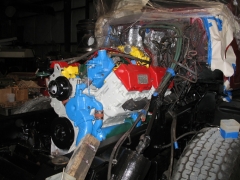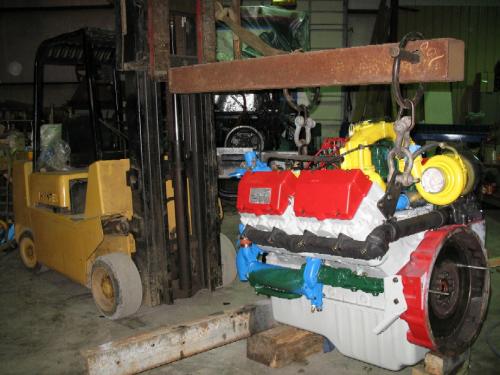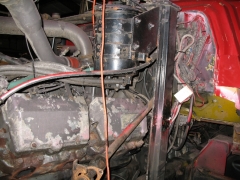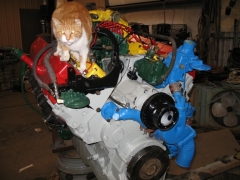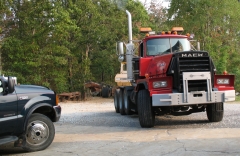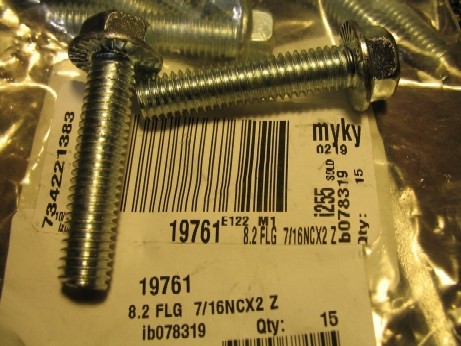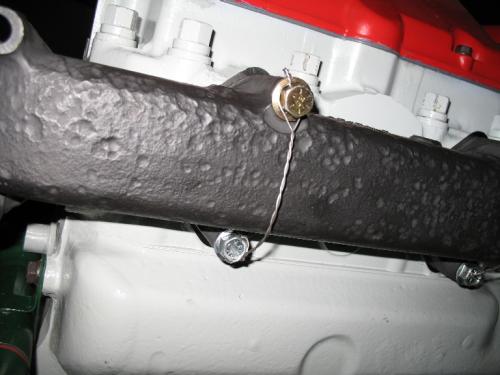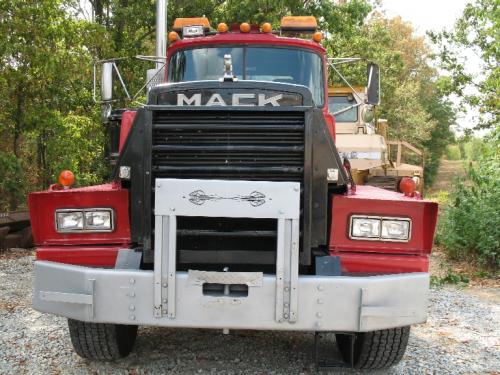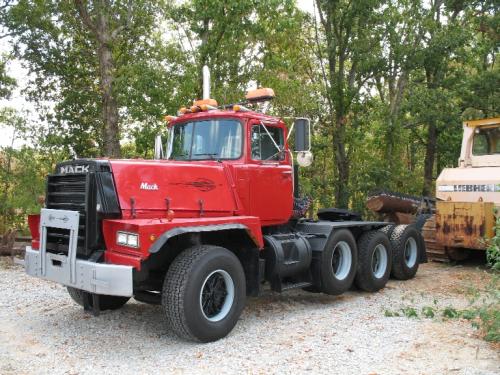-
Posts
47 -
Joined
-
Last visited
Content Type
Profiles
Forums
Gallery
Events
Blogs
BMT Wiki
Collections
Store
Everything posted by treemuncher
-

Clutch Installation And Alignment On Multi Disk Clutch
treemuncher replied to treemuncher's topic in Engine and Transmission
THAT is by far the best and easiest way to do it. I did not have the parts laying around so I manufactured what I needed. Wood is easier and faster to cut than steel and works fine as an alignment shaft. -

reworked motor set back in
treemuncher posted a gallery image in BMT Member's Gallery - Click here to view our member's albums!
From the album: RD 822s
-

Clutch Installation And Alignment On Multi Disk Clutch
treemuncher replied to treemuncher's topic in Engine and Transmission
Not yet but before it is started, it will be. Another tip for clutch alignment: the width of the spline was about 2 paint stirring sticks in width. I had already cut a pilot shaft out of wood on the lathe but I did not want to take the time to make splines. After the pilot was inserted through the disks, I clipped (with wire cutter dikes) two strips from an old paint stirring stick and drove those into the spline to align the two disks. Drive the pieces in from the flywheel side. Let them be a tight fit on the driven in side and clip off any excess. You only need to get one spline groove aligned. Secure the clutch flywheel to the spring plate with a couple of wire ties. Use 2 long bolts with the heads cut off as alignment pins to seat the assembly. Once the bolts are started on the spring plate, cut and remove the wire ties while the assembly is still loose. Tighten the spring plate and when the pilot shaft is pulled out, the pieces of the stir stick will fall down and can be blown out with an air hose. After this is completed, stab the motor to the tranny and bolt it down! About 2 hours later, the motor is mounted back into the truck. Now to start with the hoses, wiring & other connections. -

Clutch Installation And Alignment On Multi Disk Clutch
treemuncher replied to treemuncher's topic in Engine and Transmission
Thanks, Maxville. That what I thought was right, but I was unsure. It's much easier to make sure than pull the engine again after realizing there is a problem! For those who need ideas on an easy engine pulling unit, see the enclosed photo. My forks are spread approximately 15 inches - the same width as the lift rings on the motor. I've slid a 6" x 6" steel tube over the one fork to provide the required reach to the back ring. A cross piece at the end of the tube ensures that the load won't jump off of the end of the tube. There are two pieces of 2x4 stacked below the fork at the base of the 6x6 tube to keep it from tilting too far down. I also secure at least one lift ring with a tie back anchor strap so that the whole load can not slide forward and off of the forks. It takes a little throttle to lift this motor but the ride is solid and this is the easiest method I know of to pull or install a motor when working alone as I usually do. -

Neglected rusty dog with bad heads
treemuncher posted a gallery image in BMT Member's Gallery - Click here to view our member's albums!
From the album: RD 822s
-

E9 rebuild nearing completion
treemuncher posted a gallery image in BMT Member's Gallery - Click here to view our member's albums!
From the album: RD 822s
-
I'm trying to put the clutch back on the E9 but my paint marks for alignment have become somewhat less than legible from the parts washer. I can see my marks for the flywheel and backing plates but not for the disks. I don't want to put this together the wrong way. What is the correct alignment of the 2 disks? Inline, slightly offset or completely offset? I know that the splines must be aligned to slide back onto the transmission input shaft and I've already built an alignment tool to get them centered. Once this is set right, I can put the motor back in.
-

IMG_2488 alt.JPG
treemuncher posted a gallery image in BMT Member's Gallery - Click here to view our member's albums!
From the album: RD 822s
Just brought it home. This is a before picture. -
Thanks for the reply. The Mack museum sent me a copy of the original owners manual and maintenance manual. The maintenance manual corresponds with the service book that I already had. "valves must be adjusted in firing order sequence with the piston at the top of its compression stroke." TDC corresponds to the P pointer. I've already determined that with a dial indicator when I had the heads removed. The V pointer corresponds to ATDC. If these adjustments are to be made at TDC then why does the pointer not line up at the V mark if that is where TDC is supposed to be? If the timing is located via dowel pins, there should be no way to get this wrong. I've not finished the re-assembly and insertion process yet. I just want to make sure things are set correctly. I guess I will need to put the dial indicator on the rockers to see how much of a difference the 2 marks have between them in order to satisfy my curiosity and confusion on this matter.
-
I've pulled the heads for a valve job and new head gaskets. Everything is nearing completion and I am ready to set the valve lash on the E9. It has the mack engine brake. I have a Mack service manual for the motor and it says to set the valve lash at TDC which corresponds to the timing marks aligning with the P mark. My understanding is that this P references the Pump timing and the V mark references the valve timing. Somewhere, I've read where other Mack motors set their valves when the timing is set at the V mark. Which is the correct procedure? Should TDC be aligned with the P mark or the V mark? I'm thinking that maybe someone set the gear timing wrong if the V mark should be TDC. Now is the time to get this resolved while the motor is still out of the truck. I would appreciate any available expert advice on this motor. Thanks
-

E9 Exhaust Bolts - Why $15 Each?
treemuncher replied to treemuncher's topic in Engine and Transmission
Regarding the broken bolt removal, that will be up to the machine shop to do. Although I have a vertical mill myself, I will leave it to the professionals at the machine shop. At $15-$20 per removal, it is money well spent while I make money elsewhere. The exhaust valves show some minor leakage so all 4 heads will be sent out for cleaning, inspection and whatever else needs to be done to make them 100%. I only want to fix it once. Although I have to be a mechanic most all of the time, projects like this do not make my day. And, while the heads are off, out comes the motor to replace the rear main seal and possibly, the transmission front seal. The clutch will be inspected and a new throw out bearing installed if necessary. The radiator will be sent out for rodding and cleaning while it is removed. In for a penny, in for a pound. I want it done right the first time and I don't want to see any oil on the ground after I'm done. It is far less expensive money and timewise to get all of this done at one lick. I'm seriously considering allen head cap screws for the manifold bolts. These are extremely tough and reasonably priced. -
I've started to troubleshoot and nitpick on the new-to-me dog. I have two broken exhaust bolts in two different heads and the exhaust gaskets were shot. All of the bolt heads are in rough shape from salt damage and weathering so I plan to replace them all. 20 pieces total plus the other 4 that connect to the 90 degree elbows. I've gotten pricing from 2 different Mack dealers and they both quoted me roughly the same price right at or near $15 each piece. That adds up to over $300 for bolts! What is so special about these shouldered bolts that makes them such a high priced item? I can purchase grade 8 or 9 bolts for $1-$3 each. These bolt don't encounter exhaust gasses directly and there is nothing special looking about them except for the shoulder. A shiny new washer under a shiny new grade 8 bolt will act just the same. A dog on the top of the bolt is not worth that price to me. Sounds like someone moved a decimal point the wrong way. OK members, what say you??? UPDATE: I've purchased bolts through Fastenal to replace the original Mack bolts that were so severely corroded. I ordered stock # 19765 and #19761 in case any one else runs into the same problem. The cost for 15 units of each stock number was $58.20 and $26.70, respectively, or $3.88 and $1.78 each. Total bolt cost was $84.90 + tax. There should be about 6 bolts left over for back up. These are grade 8.2 flange head bolts. Although both numbers are listed as serated shoulder type, only the 19761 bolts are serrated. All threaded holes were re-tapped prior to installation. All threaded surfaces were liberally coated with antisieze and torqued to 55 ft-lbs. No fold - over bolt locks were included with the upper gasket set so I drilled out the bolt heads and installed safety wire locks to help keep anything from coming loose. Total machining time was 1.0 - 1.5 minutes per bolt and 3 drill bits. As time permits, I will try to post on the Wiki link for tips on machining these hardened bolts, rebuilding joint problems on the exhaust manifolds and other problems solved on the E9
-

Window Felts & Rubber Seals
treemuncher replied to shinermack's topic in Modern Mack Truck General Discussion
Hey Barry, How about offering door glass rebuild kits for some of the more common Macks. Every Mack that I have owned so far needed new felt base strips and the upper channels. I have yet to see a used Mack that did not need work done on the door glass works. A complete rebuild kit would be a faster and easier alternative than ordering individual parts and less worry that no mistakes were made in the process of ordering. If I am not mistaken, all of the R models use the same door whether R, RW, RD, etc. Maybe this is too easy, but it's just a thought. If this works, how about a discount for all of the BMT members?? I would purchase a kit faster that the components because I would know everything was done right the first time and I would not have to go back in a year or two just to replace more parts. -
I've determined that the exhaust manifolds are leaking at the joints where the male-female couplers are. Is there any easy fix to get these tightened up? The loss of the exhaust pressure will have a serious impact on the performance of the turbo charger as it did on my ford 7.3. I want to get these tightened up or replaced. Any suggestions?
-
Bulldog Man, I just listed the Superliner in http://www.truckpaper.com/listings/detail....03CD6CF151A2D3C for a starting price of $16,500. That's just an asking price. I've listed a lot of specific details about the truck on the ad. The interior is not super pretty but it has a great gauge package and everything works except for the ac. I will try to get some better pictures up to the ad tomorrow or the next day.
-
I'm needing info on the fuel gage system. I found this website http://www.panteraplace.com/page107.htm which, although a car schematic, contains lots of basic wiring information that can help with some troubleshooting of the electrical system. Most electrical hookup are the same principle and a simple schematic such as these can help.
-
Thanks for the input, guys. Bulldogman, yes, I purchased it from the dealer ion Fort Wayne, IN this past week. I never did see their ad on Ebay. How much was it listed for on the Ebay site? It is not a perfect truck but with some work, I am sure it will last me for as long as I am in business. My E 350 4v Superliner flexed a lot and did not have enough power to suit me to pull my loads up the local hills. I usually gross 95K on my regular smaller load and 120K+ with the dozer. I hope the big dog makes the grade for me. If not, it will be up for sale after I find something better. It's not decked out as nice as the Superliner but I need a work truck more than a road truck. The Superliner will be up for sale in the next few months if anyone has an interest in a fine lowboy truck.
-
I would like to second this request. I need the wiring schematic for a '92 RD 822s. I have issues with the gauges and dash wiring. If I find anything elsewhere, I will post a link here.
-
I just purchased an RD 822s. It is a truck among trucks and I want to make sure that I take good care of it. It will be used as my lowboy truck and to occasionally haul my dump trailer. I am looking for the following advise: 1. Any known problems or things I should be careful of with the E9 motor so that it is not damaged? (besides turbo temp, proper cool down) 2. What is the best way to combat rust and corrosion on this truck? There is an extensive amount of salt corrosion that has set in. 3. Any place where I might get a copy of an original owner's manual? 4. Any special advise for the Mack 12 speed tranny? 5. My front fenders look "droopy" as though they have been bent down. Maybe too many rough roads? 20k front axle and 50k cb rears make for a rough ride. Could this cause them to sag over time? Only 90k miles on the truck. 6. Is any history available on this model of trucks? I believe this is one of the last years this model was produced from what little I have read. 7. Any recommendations for the mirror mounts on the doors? The excessively rough ride on this truck has weakened the doors where the mirror frames mount. I want to solve this problem before the doors get cracks as they have on my RW. I was told the truck came out of NY, has previous yellow paint like the state trucks and lots of salt corrosion most everywhere. The salt damage is my biggest long term concern. I know I need battery boxes and covers to start, new exhaust and detailed sandblasting to get the rust bubbles out. There will be lots of clean up and detailing to do provided I like the truck and decide to keep it. I don't see how I won't fall in love with it after all of the stories that I've heard about the E9 500's. I'll be ready to sell off my RW613 as soon as I give the new truck a good inspection and shake down. The Superliner is a nice truck but the E6 350 just won't cut it for my heaviest load. It's no fun when the tail tries to wag the dog! I want a dog who can wag any tail no matter how big!
-

E6 350 4v Short On Power, Worse Than Ever, Gutless!
treemuncher replied to treemuncher's topic in Engine and Transmission
UPDATE: As of last week, I finally pulled my trackhoe home with the old dog. I usually gross about 92k - 95k lbs loaded. Before following the posts on this site, every little hill knocked the tar out of my speed but now that the fuel has been increased to a more reasonable level, fewer shifts are required and you can finally feel the old dog pull. It is still a dog and slow to get to speed. I expect it always will be but at least, now it pulls with a firm grunt! I think an adjustment of advancing the timing would probably help the horsepower but I doubt I will mess with it. I still don't get above 925-950 degrees on a long hill so I think that I can still increase the fuel rate IF I machine down the locking nuts within the fuel pump. These are currently maxed out but the old wear marks on the pump show that it used to deliver considerably more fuel than the current setting. I think the nuts were replaced during the rebuild and have a taller profile than the originals did. Anyway, for a little increase in smoke, I've had a big increase in performance. Thank you to the members of this board who help others with your step by step instructions and all suggestions. I hope that I can share my expertise and help others in the future. -

E6 350 4v Short On Power, Worse Than Ever, Gutless!
treemuncher replied to treemuncher's topic in Engine and Transmission
Thanks for all of your inputs. I ran the valve clearance again, checked and cleaned one injector (#6), turned up the fuel according to one of the posts I found on this site and checked for good flow out of the supply line. I would guess it pumped between 8-16 oz into the bucket within a 10 second cranking period. To me, that flow should seem sufficient. I would appreciate any comments on required flow rates and pressures that I should expect to the pump. I took it out for a test drive with an empty trailer and it finally leaves a smoke trail like an old dog should. The pyro still only hit 950 pulling a long hill at 1200 rpms in top gear but the turbo was hitting 25+ psi on a summer day, which is better than ever. I won't know how much better it really is pulling until I move my trackhoe but it sure seems to be better than before. My lowboy has always been a tough pull compared to my old dump trailer, but the lowboy is what is used 95% of the time. The only problem that I had turning up the fuel was that the adjustment screw was nearly at the end of its travel prior to my adjustments. Now it is at the end of its available travel. Does the little sloped ramp piece on the fuel stop adjust down? This would provide more travel if it did. I can see on there where the wear mark is from the previous adjustment and it looks like it used to run considerably more fuel than it currently does. This is a reman AMBAC pump that I got when my old one seized a few years back. Anyone have any comments on an e9 500 hp mack v8? I had one dealer tell me they were junk. Others have told me they are real pulling monsters. I'm tired of dealing with this slow old dog of mine and I've been looking at CL's or CH's with 450+ hp, 18 spd and heavy axles. I want to move up to cruise control and a nicer ride for my longer trips. Got to live a little! -
I'm very glad to have found this website - THANK YOU, THANK YOU!!! Patient: 1986 RW613 Superliner w/ Mack E6 350 4v motor, 13 spd eaton, 4:42 ratio, lacks power to get out of its own way Symptoms: max about 950 degrees under load post turbo, max 22-25 psi turbo pressure depending on weather conditions, operates around 190 degrees on coolant temps, 30-65 psi oil pressure dependent on rpm's, air cleaner restriction less than 5 on the meter. Last pull home with 15k lbs on a 50 ton lowboy trailer - truck takes close to 1/2 mile to get to 55 mph on nearly flat ground. Some light smoke under load but not excessive. Truck is normally used to pull a 92k - 95k lb gross weight load. Past history: Motor out of frame less than 10k miles ago, new rings & new bearings installed. Mack stamped .010 crank and all parts still showing hone marks & looking like new. Valve jobs done on both heads. Rebuilt injectors installed. Within last 5k miles installed a rebuilt fuel injection pump after old one siezed up. Mack set the fuel timing last year & dyno test showed 265 hp output. Repaired leaking intercooler last year. Puff limiter valve on front of AMBAC pump has never been connected or working to my knowledge. The truck has always been slow but then again, it was always much faster than the old B61 I started with! The truck sits sometimes for months at a time before it is used. My last check of the fuel flow looked good, the vent tube on the fuel tank is routinely checked as dirt dawbers have clogged that in the past causing problems. While the fuel filters have not been changed recently, they have not seen 3k miles yet. I do not believe that they are the problem. I'm thinking that this puff limiter valve could be an issue although the injection shop made no mention of it when I got the rebuilt pump. I plan to go over the valve adjustment again while it is here at the shop. Last check of the turbo and the intake system looked good without any slop or serious leakage. The EGT seems low most of the time like there is very little fuel getting to the engine. Prior to Mack setting the fuel timing, I had timed it by ear and smoke and they said I was very close. It ran better the way I had it adjusted but it has always been slow on the pull. The dyno test proved my thoughts that this engine was putting out less than it should be. Any suggestions to remedy this situation would be appreciated. I'm even considering turning up the pump if that will help. I've about had it with this old mutt and I'm thinking of looking for a replacement if I don't get it to behave!
BigMackTrucks.com
BigMackTrucks.com is a support forum for antique, classic and modern Mack Trucks! The forum is owned and maintained by Watt's Truck Center, Inc. an independent, full service Mack dealer. The forums are not affiliated with Mack Trucks, Inc.
Our Vendors and Advertisers
Thank you for your support!



